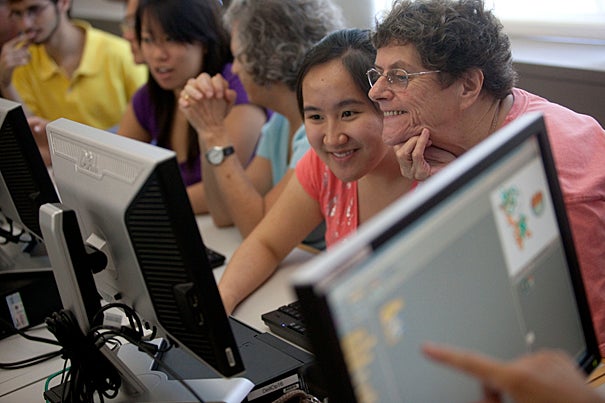
Harvard Institute for Learning in Retirement students worked one-on-one with students from CS50: “Introduction to Computer Science I” to learn Scratch, a programming software developed at MIT. Yunsoo Kim ’11 teaches Bridget Dinsmore the program, which involves manipulating an avatar of an orange cat.
Kris Snibbe/Harvard Staff Photographer
Easy blend of old and new
Retirees flock to class creating computer programming
Sally Martin has taken courses in dance, literature, and science as a student at the Harvard Institute for Learning in Retirement (HILR). But a computer science class? Martin was dubious about that.
“Truthfully, I asked my son if he thought I’d like it,” she revealed. “And he told me it looked like fun.”
Martin was one of a large group of HILR students who took a seat in a computer lab Tuesday (Aug. 31) to learn Scratch, a basic programming tool created at the Massachusetts Institute of Technology that allows users to produce interactive stories, animations, games, music, art, and more.
Teaching Scratch was a group of teaching fellows and course assistants from CS50: “Introduction to Computer Science I,” a popular Harvard course taught by David Malan, a lecturer on computer science.
“CS50 historically starts each year with a training week for its teaching fellows and course assistants, and though we both discuss and practice teaching during that week, we decided to create as real-world an experience as we could for the team, so that their pre-term teaching wasn’t wholly simulated but, rather, very much real,” said Malan.
“As luck would have it, in the HILR we have a wonderfully enthusiastic student body, many of whom haven’t yet tried their hand at programming. And so we thought we’d bring the groups together for the day to teach and learn together.”
The class teaches a fundamental understanding of computer science and culminates in a presentation of the students’ original work.
“Scratch imitates a programming language with these puzzle pieces you put together instead of dealing with syntax,” said teacher Ana Roda ’12. “You can do lots of fun little things with it.”
HILR student Betty W. Stone hoped to do just that. “I’m teaching a course on Bauhaus at HILR this semester, so I thought I’d learn Scratch so the students could use it to draw with and really see what the artists were up to,” she said.
Scratch begins with an avatar called a sprite, which is by default an orange cat. Users can paint their own unique sprites or pick from a template of characters.
“With these commands, you can make the sprite move, give it dialogue, make sounds,” Robert Nishihara ’13 explained to his HILR partner, Rita Colella. Together, they dragged a series of basic commands that resulted in the sprite moving forward 10 steps and uttering, “Hmmm….”
“Oh, there it goes,” laughed Colella. “What else can I do with this?”
Victoria Jones took to Scratch right away. First, she made her own sprite, “Devil Cat,” called so because of its red horns. Then, she programmed it to ask her how she was doing. Jones’ response? “I’m hot!” Indeed, it was warm in the upstairs computer lab.
Her teacher, Punit Shah ’12, immediately sensed her potential. “Now we can teach it to make a decision based on what you’ve just said,” he suggested.
“I’m making a storyline here!” she said, and with that drew two new sprites, the orange cat in a flattering teal swimsuit, with sunglasses, and another in a gray winter coat.
“Now we’re ready to write the program,” said Shah.
Using tools she’d learned in under an hour, Jones programmed her sprite to switch costumes, depending on the season.
Jones, a former documentary producer who continues to do freelance work, was working for the Obama campaign when someone recommended she check out the HILR and its lifelong educational offerings.
“Just like anything else that isn’t used, your mind rusts,” Jones said. “Just like you exercise your body, you have to exercise your spirit, your mind. You never stop. You never stop.”




